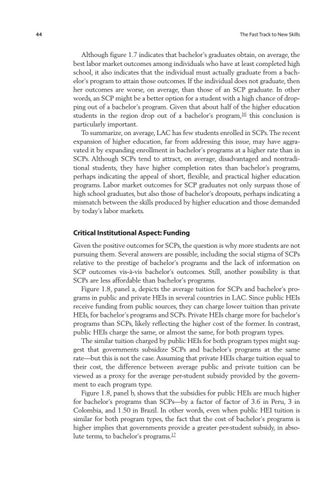44
The Fast Track to New Skills
Although figure 1.7 indicates that bachelor’s graduates obtain, on average, the best labor market outcomes among individuals who have at least completed high school, it also indicates that the individual must actually graduate from a bachelor’s program to attain those outcomes. If the individual does not graduate, then her outcomes are worse, on average, than those of an SCP graduate. In other words, an SCP might be a better option for a student with a high chance of dropping out of a bachelor’s program. Given that about half of the higher education students in the region drop out of a bachelor’s program,16 this conclusion is particularly important. To summarize, on average, LAC has few students enrolled in SCPs. The recent expansion of higher education, far from addressing this issue, may have aggravated it by expanding enrollment in bachelor’s programs at a higher rate than in SCPs. Although SCPs tend to attract, on average, disadvantaged and nontraditional students, they have higher completion rates than bachelor’s programs, perhaps indicating the appeal of short, flexible, and practical higher education programs. Labor market outcomes for SCP graduates not only surpass those of high school graduates, but also those of bachelor’s dropouts, perhaps indicating a mismatch between the skills produced by higher education and those demanded by today’s labor markets.
Critical Institutional Aspect: Funding Given the positive outcomes for SCPs, the question is why more students are not pursuing them. Several answers are possible, including the social stigma of SCPs relative to the prestige of bachelor’s programs and the lack of information on SCP outcomes vis-à-vis bachelor’s outcomes. Still, another possibility is that SCPs are less affordable than bachelor’s programs. Figure 1.8, panel a, depicts the average tuition for SCPs and bachelor’s programs in public and private HEIs in several countries in LAC. Since public HEIs receive funding from public sources, they can charge lower tuition than private HEIs, for bachelor’s programs and SCPs. Private HEIs charge more for bachelor’s programs than SCPs, likely reflecting the higher cost of the former. In contrast, public HEIs charge the same, or almost the same, for both program types. The similar tuition charged by public HEIs for both program types might suggest that governments subsidize SCPs and bachelor’s programs at the same rate—but this is not the case. Assuming that private HEIs charge tuition equal to their cost, the difference between average public and private tuition can be viewed as a proxy for the average per-student subsidy provided by the government to each program type. Figure 1.8, panel b, shows that the subsidies for public HEIs are much higher for bachelor’s programs than SCPs—by a factor of factor of 3.6 in Peru, 3 in Colombia, and 1.50 in Brazil. In other words, even when public HEI tuition is similar for both program types, the fact that the cost of bachelor’s programs is higher implies that governments provide a greater per-student subsidy, in absolute terms, to bachelor’s programs.17

